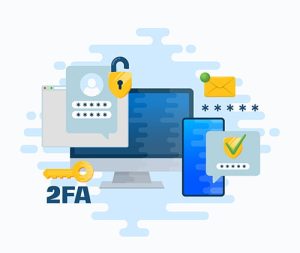Credential stealing is now at an all-time high, and it’s responsible for more data breaches than any other form of user attack.
Because data and business processes are increasingly cloud-based, a user’s password is the fastest and simplest method to execute a wide range of harmful activities.
If you’re logged in as a user, even if they don’t have admin permissions, a criminal can use your company email account to send out phishing emails to your employees and clients. The hacker may also encrypt your cloud data and demand thousands of dollars for its restoration.
What measures can you take to keep your online accounts, data, and corporate operations safe? Multi-factor authentication (MFA) is one of the finest methods for protecting your online accounts, data, and business operations. Even if a cybercriminal has a genuine user credential to log in, it provides a significant obstacle. Because they are unlikely to have access to the device that receives the MFA code necessary to finish the authentication process, they will most likely not be able to do so.

The 3 Common MFA Methods
It’s critical to evaluate the three primary MFA techniques instead of simply thinking all methods are identical when you use multi-factor authentication at your company. There are significant distinctions between some and others, making some more secure than others but also making them more inconvenient.
1. SMS Code
The most popular form of MFA is SMS-based. This one uses text messaging to authenticate the user. When creating MFA, most people enter their mobile phone number. Then, when they log into their account, they will receive a text message with a time-sensitive code that must be entered.
2. APP Authentication Code
Another variant of multi-factor authentication uses an app to generate the code. The seed code is known by the server and the users device only which is randomly generated at initial setup. The user still generates the MFA code when it needs to be used, but it’s generated through the app rather than received on-demand by SMS.
3. Security Dongle
The third way to MFA is to employ a separate standalone security key that you insert into a PC or mobile device to authenticate your login. The key itself is obtained at the time the MFA solution is set up, and it will be the thing that generates the authentication code and applies it automatically. The seed is stored on the security dongle.
The MFA security key is typically smaller than a traditional thumb drive and must be carried by the user to authenticate when they log into a system.

What is the easiest MFA to Use?
MFA can give the impression that it is slowing you down. This might be more difficult if they are required to learn a new app or try to remember a tiny security key (what if they lose it?). Users might leave their cloud accounts less secure if they do not use multi-factor authentication as a result of this user difficulty.
The SMS Code MFA is the most convenient form of MFA if you’re experiencing user resistance and want to know what’s the best option for you.
Because most people are already familiar with receiving text messages on their phones, there is no new learning curve or software to download.

WHAT IS THE MOST SECURE MFA METHOD?
If your firm keeps sensitive data in a cloud environment, such as a web accounting program, you should consider MFA security if you haven’t already.
The security key is the most secure type of MFA. In the event that your phone is lost or stolen, the security key, being a distinct gadget, will not leave your accounts unprotected. In this situation, both the SMS-based and app-based versions would put your account at risk.
The SMS-based option is the most insecure because a SIM Card might be cloned, allowing a hacker to steal those MFA text messages.
A Google research assessed the efficacy of these three MFA alternatives in preventing three distinct types of assaults. Overall, the security key was the most secure.
Percentage of attacks stopped:
• SMS-based: Between 76 and 100 percent
• On-device app prompt: Between 90 and 100 percent
• Security key: For all three attack types, 100%



